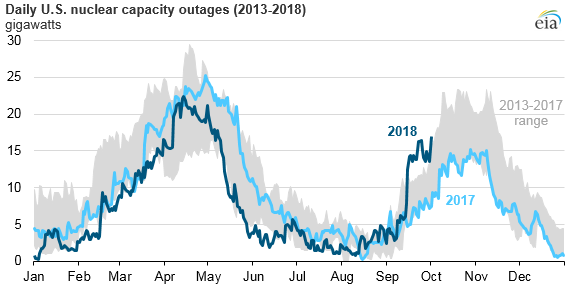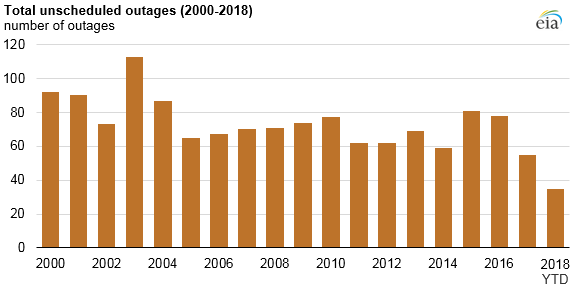Electric generation capacity losses as a result of U.S. nuclear plant outages were relatively low during much of the 2018 summer, averaging 2.8 gigawatts (GW) from June through August. This year’s seasonal maintenance and refueling cycle began earlier than in recent years, and total nuclear outages averaged 14.5 GW in the last week of September. The earlier-than-expected retirement of the Oyster Creek Generating Station and a temporary plant shutdown related to Hurricane Florence also increased outages in September.

A scheduled shutdown of a nuclear power plant is generally timed to coincide with the plant’s refueling cycle. Nuclear power plants typically refuel every 18 to 24 months, often during the fall and spring when electricity demand is lower. During a refueling outage, plants typically optimize downtime by scheduling facility upgrades, repairs, and other maintenance work to be completed while the reactor is offline.
During the past six years, average refueling outages have become shorter, decreasing from an average of 46 days in 2012 to 34 days in 2018. The decrease in refueling outage times is a result of greater operator experience in regulated markets and competition from other generators in unregulated or wholesale electricity markets.
During a refueling outage, the reactor is entirely shut down and produces no electricity and, therefore, no revenue. Plant operators try to minimize lost revenues and non-operating costs by bringing reactors back online as quickly as possible. In 2017, six U.S. reactors had refueling outage times of less than 20 days: Peach Bottom Unit-3 (15 days), Vogtle Unit-1 (16 days), Nine Mile Point (17 days), Quad Cities (18 days), Dresden (18 days), and Three Mile Island Unit-1 (19 days).

Three unscheduled outages in Tennessee, Arkansas, and Arizona affected the available summer capacity in 2018. Tennessee’s Watts Bar Unit-2, the newest U.S. nuclear power plant, automatically shut down for six days after a main turbine and generator tripped on June 22. Arkansas Nuclear One Unit-1 shut down from June 23–26 to repair a leakage in the reactor coolant system. The Palo Verde Nuclear Generating Station Unit-3, located 45 miles west of Phoenix, Arizona, automatically shut down for three days beginning June 27 because of low steam generator water levels.
Hurricane Florence caused a nine-day unscheduled outage at the Brunswick Nuclear Plant near Wilmington, North Carolina, in mid-September. The 1,870 megawatt (MW) facility is located about four miles from the Atlantic coast and was safely shut down by plant operators before hurricane force winds and flood waters reached the site.
Also in mid-September, the 625 MW Oyster Creek Nuclear Generating Plant in Forked River, New Jersey, permanently shut down. The plant was previously expected to retire on December 31, 2019, but the timeline was accelerated by more than a year to coincide with the end of the plant’s final fuel and maintenance cycle. The retirement of the plant is considered an unscheduled shutdown in EIA data until the Nuclear Regulatory Commission amends its outage data to reflect the closure.
Total unscheduled outages as a result of these plant shutdowns decreased from 85 in 2015, to 78 in 2016 to 55 in 2017, and to 37 so far in 2018. These outages can fluctuate year to year based on plant technical issues and external circumstances.

Principal contributor: Slade Johnson

Follow us on social media: